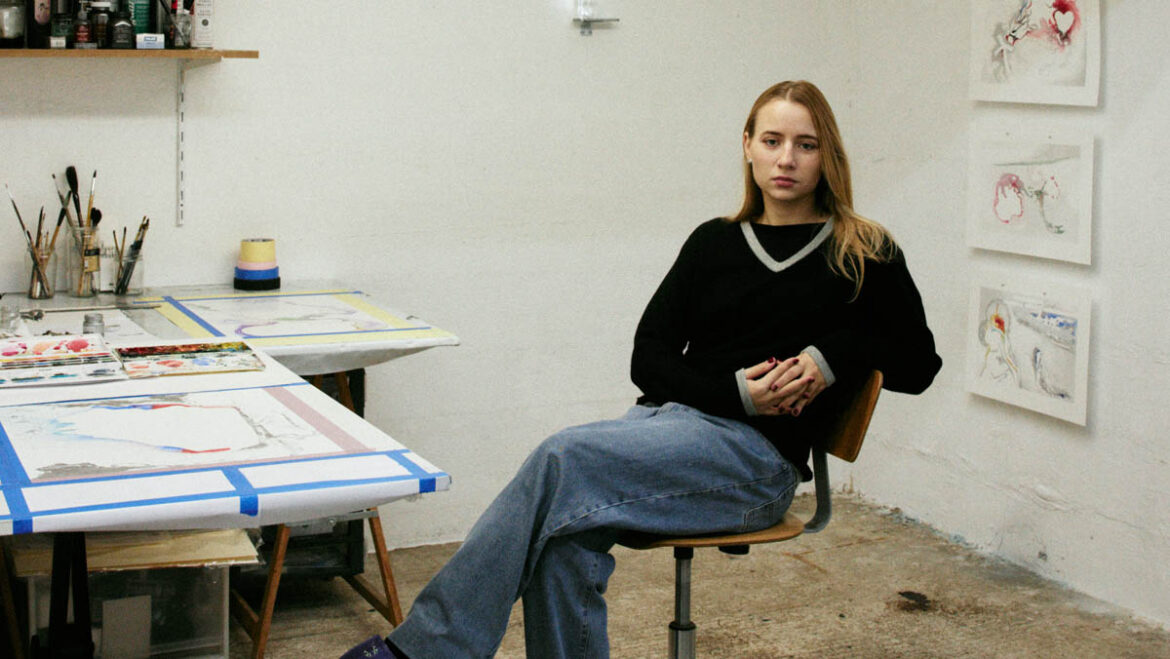
Erka Shalari: I would like to ask you about your background, and then about the media you work with.
Ekaterina Costa: I was born into a multicultural, international family – my mother Russian and my father American with Portuguese, English, and Swiss roots. Growing up in Moscow, I traveled a lot, and at home we spoke multiple languages. My parents actually met studying German linguistics in pre-unification Germany. Home was a melting pot mix of different traditions, religions and languages. I moved to Paris 12 years ago to study fine arts at Parsons, and since then, the city became the anchor for my practice, although I still work nomadically across countries and residencies. Perhaps because of this background, my artistic practice gravitates toward memory and the fragments that represent it.
I collect objects and images in a personal archive, amassed as a physical collection of items in my studio, and a vast digital archive on my phone. I’m a bit obsessed with documentation and recording things that are lost, or in transition. These bits of personal or collective memory become the starting point for works across different media: sculpture, installation, drawing, and photography. I tend to work in whatever medium best carries the story or concept at hand; and I’m especially drawn to mediums that allow for multiple readings. For instance, readymade objects, whether found, inherited, or acquired, interest me for the histories and cultural mythologies embedded within them. I also investigate themes of absence and negative space, the idea of “manque” in French is a good word to describe it.

Often, the margins and traces, the things left unsaid or barely visible, speak more about a history or iconography than the primary subject itself. I find that what is missing or fleeting can be more pertinent than the direct principal subject. In practice, this means I’m drawn to materials and themes that are ephemeral or liminal. It could be a found object transformed completely into a new context, or another form of translation – say, taking a low-resolution photograph from my iPhone library and turning it into a 3D laser-engraved crystal piece, like with my series Souvenirs de Poche. Still, drawing remains a central pillar in my practice. It is a process I can compare to journaling or thinking, a gesture of immediacy and intimacy that serves to counterbalance the longer-production installations or sculptures that can take months to take shape and produce before I have a physical piece I can touch and see.
I was curious about the materials you work with: Lana Vanguard paper, found objects, silicone, plexiglass… Why these materialities?
Many of the materials I work with embody impermanence and transformation; they often have an integral fragility or instability. I’ve used Lana Vanguard, a synthetic polypropylene paper, extensively over the past two years. It is ultra-smooth, bright white, and extremely resistant. Originally, it was used for digital printing techniques and technical drawing. I like its artificiality and durability. Also, it is non-absorbent, so when I apply watercolour or powdered pigments, they sit on the glossy surface like a delicate veil. Before fixing it with a varnish, the created image remains extremely fragile, meaning I can work and rework a piece endlessly through erasure and addition, without the paper degrading. I’m also drawn to the end result, which can resemble a digital print or photograph, with a high-gloss, ultra-smooth finish. The process behind how the image was made is not immediately obvious, which adds to that ambiguity between the handmade and the digital.
In sculpture, I often work with reflective or transparent materials like silicone, glass, crystal, or resin that sit on the edge of visibility. They have tangible weight but also a certain elusiveness, revealing and concealing at the same time. They can act like time capsules. Glass can be a barrier or a magnifying lens. I think of these encapsulating materials as timekeepers: they preserve and refract an object or image, like amber trapping an insect for millennia or a museum vitrine elevating a mundane artefact. They hold memory up to the light. I have also begun to increasingly incorporate found objects into my sculptural work. Every object carries a mythology and history; it bears physical marks and energy from its past lives of use. Sometimes it’s ironic or serendipitous how some of them come into my possession, and those circumstances become part of the work’s narrative.
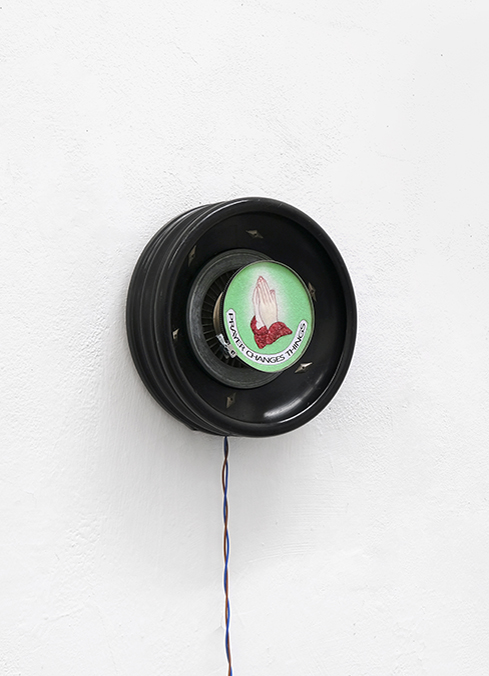

In works like The Cranes Are Flying, The Gambler: Reasonable Doubt, there’s this recurring element of rotation, of spinning. I have the feeling that this movement carries something essential — why was it important to you that these works contain this kind of driving motor? Further also in drawing series Homing 2023-2024 there is this element of flying.
The first two works were created during my residency at VIR ViaFarini in Milan earlier this year, and they both incorporate this circular motorized rotation. Circular movement appears across my recent works because it is non-linear. A perpetual loop resists clear beginnings or endings — it mirrors how memory recurs, how thoughts return, and how certain life events repeat in cycles rather than progressions. In line with the themes of these works, chance and belief operate in parallel: both rely on ritual to cope with uncertainty. The perpetual rotation creates a suspended expectation that never truly resolves. The Gambler assembles an antique roulette wheel with a kitsch decorative found object of lowbrow religious iconography that reads “prayer changes things” and depicts hands in prayer. When it’s set in motion, we are literally watching and waiting for the ball to drop, like a built-in suspense cycle that never truly resolves. Extending from the circular body of the sculpture is the long twisted wire plug. I like how this element resembles prayer beads, and the naïf sand-collage image contrasts with the smooth, polished wood of the antique auction-acquired roulette. The rotation in The Gambler holds both the possibility of chance and a sense of inevitability, in the perpetuity of open-ended movement. It is an exploration of different mechanisms of faith and chance: whether it’s prayer beads or lucky dice or a spinning wheel of fortune, we have many rituals to cope with uncertainty.
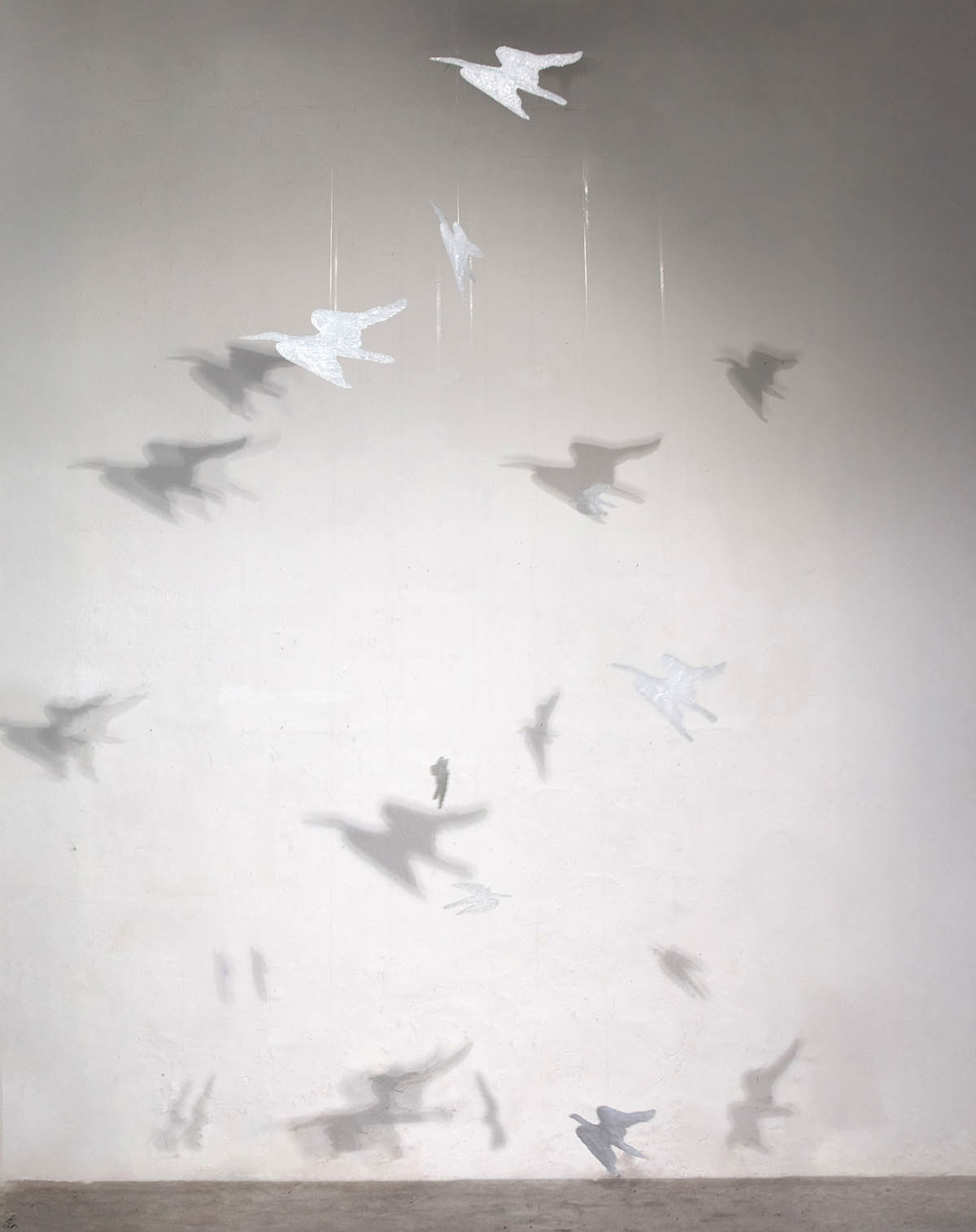
In The Cranes Are Flying, there is also a nod to toys, games… The circular suspended structure of the silicone and plexiglass birds is inspired by a child’s mobile. Here, I set in motion a flock of cranes circling in permanent migration. They orbit in a familiar, gentle motion that is comforting but also slightly disquieting, casting shadows around the room. The title of the piece references the iconic 1957 Soviet film The Cranes Are Flying, a story of love and loss during wartime and cycles of life, which are often referenced in Slavic and Russian folklore through the metaphor of migratory birds — and cranes specifically. In the drawing series Homing, there is no kinetic element to the work, and the motion is implied. The series depicts homing pigeons — birds that can travel vast distances to return to one specific place: home. They are depicted in various states of flight or collapse, and there is an intentional ambiguity as to whether some are dead or others in flight. Each drawing in the series is titled with aviation terms like Headwind Climb, Nosedive, or Layover.
In a previous conversation, you mentioned that someone has remarked that your drawings could also be seen as paintings. Still, you said you prefer to think of them as drawings. Could you elaborate on why that distinction is important to you?
My friend Rose Ras asked me this question in residency at La Chapelle Saint Antoine in Greece this summer. I had to think hard about it honestly, because this nomination is just what feels organic. Perhaps, I insist on “drawing” because the term defines both my approach and the viewer’s relationship to the work. Drawing, for me, is a way of thinking on paper. It allows for hesitation, revision, removal. When I call my works drawings, I’m aligning with a certain mindset. It implies openness and fluidity; a medium of exploration and process. Painting carries a different cultural weight: it implies resolution, a final statement in my mind. I’m more interested in the state before closure. I like to preserve this uncertainty across all the mediums and materials I work with.
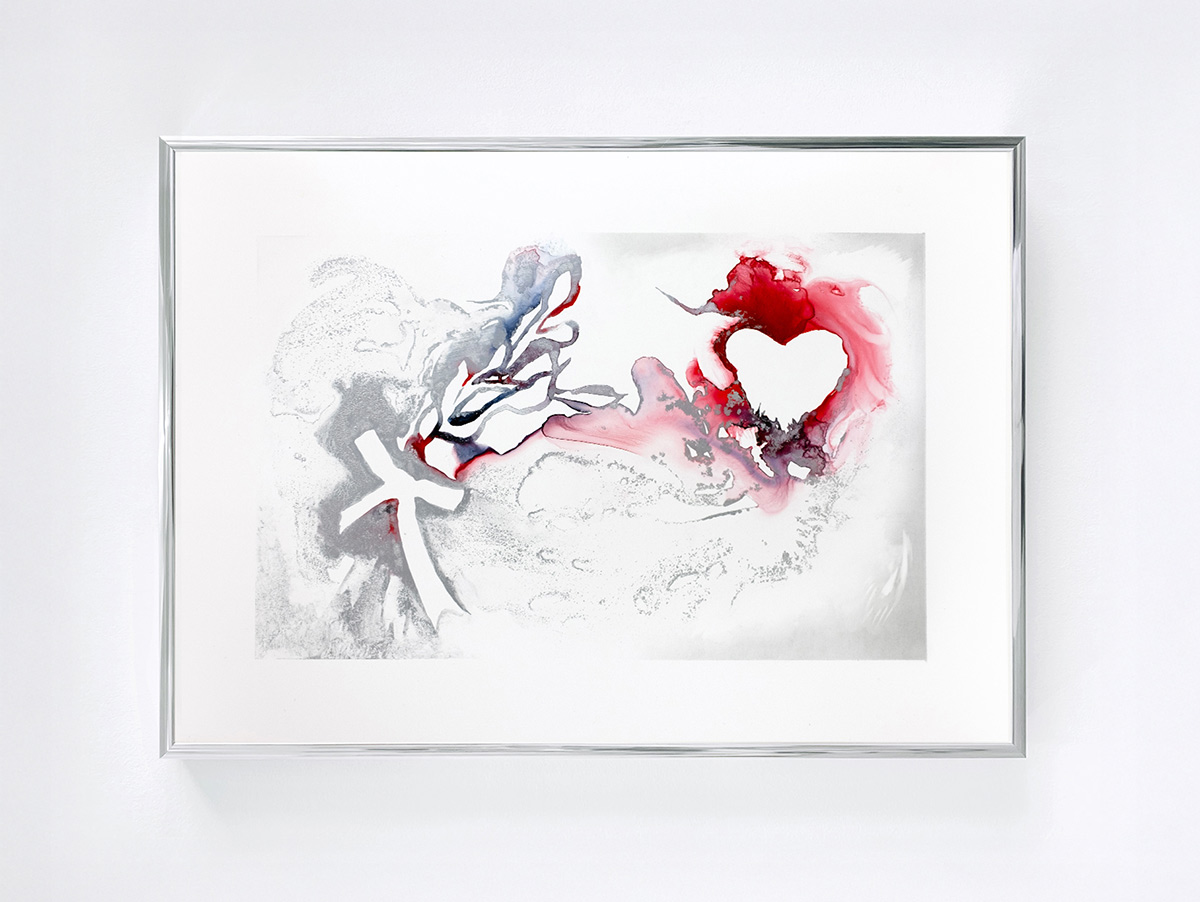
La Traversée, the body of work for which you were nominated for the 10th Dauphine Prize for Contemporary Art in 2023, brings next to each other images of the physiological changes observed in your mother’s dying body and internal transformations within you, rendered in a very poetic abstract visual language, through surfaces that recall fish skin, seafood…
La Traversée (French for The Crossing) is one of my most personal works. In late 2021, I moved back to Moscow to care for my mother, who was terminally ill. She passed away in February 2022, and a few days after that, Russia invaded Ukraine and I returned to France.. 2022 became a year split in two for me: a clear before and after. La Traversée emerged directly from that experience. The piece takes the form of a dual slide carousel projection. The content of those slides comes from two distinct series of photographs I took over the course of 2022. The first is shot in Moscow — the before. The latter I shot in France, in the months after my return. The first depicts photographs of my mother during her final weeks, images of the empty apartment, close-ups of the physical realities of illness and death, the body in decay. The second series captures photographs of raw seafood at markets in Paris — glistening fish, blood, scales, and flesh on ice. Upon my return to France, I found myself often going to open-air markets as a ritual that grounded me. It was a return to life, visceral and a bit grotesque, continuing amid grief. Both sets of images deal with flesh, the body, with interiors and insides. The theme of the Dauphine Prize that year was „Monstrueux, le Merveilleux à Rebours” (“The Monstrous and the Marvellous, inside out”), which we interpreted through this project with curator Sonia Kovaleva, leaning into the duality of the monstrous and the marvellous as two sides of the same coin.
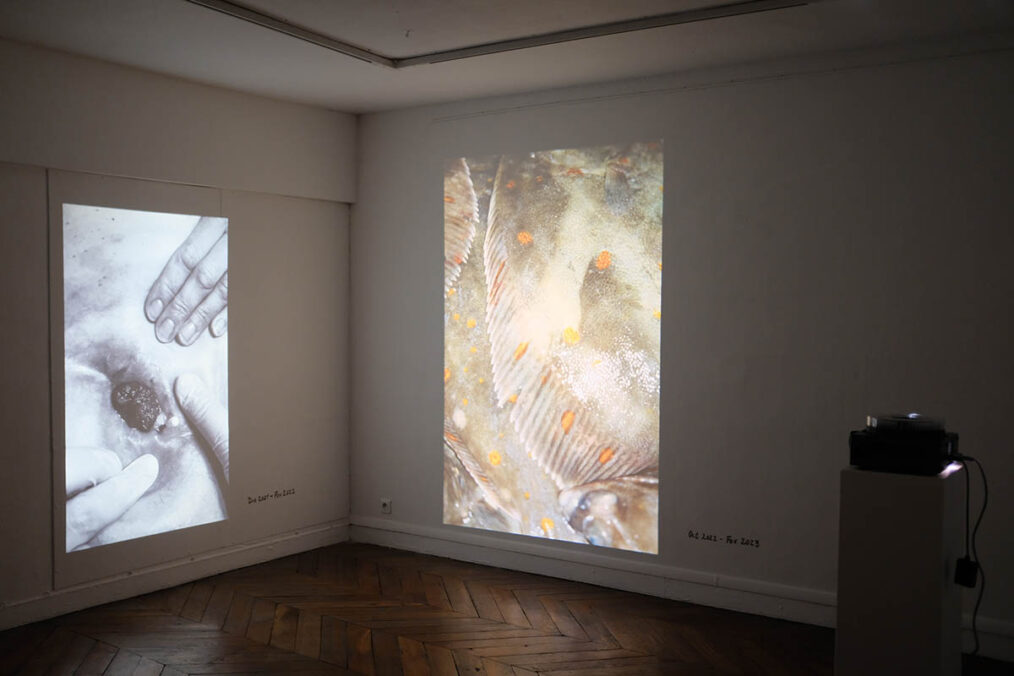
Photo: Courtesy of the artist
I am thinking at this point also of the carousel form of images; I feel very drawn to it. What fascinated you about this way of displaying, and why was it important to you that the slide projectors were asynchronous?
The installation consists of two carousel slide projectors in a dark room, each clicking through a tray of 40 slides. The projectors are asynchronous, so every time the slides advance, a different juxtaposition appears, one at a time, creating an ever-changing conversation between the images. The viewer never sees the same diptych twice. These elements of chance somehow reflect how memory functions after trauma — fragmented and nonlinear — and make space for moments of impact and moments of misalignment. I did not want a clean before/after, but rather to reflect on an experience of fragmentation, of passing through the experience of loss, of grief, of death, of exile, and coming out the other side.
The title of the piece speaks to this idea, too. Using a carousel projector came clearly from the archival context of the collection of images, but also from the intimacy and familiarity it implies. As the slides click through, there’s that whirring and the warm, dim light, like family nights in a living room. There’s an intimacy and melancholy. Formally, it embodies sequencing, repetition, and interruption, but it also brings an analogue tactility: the click, the brief blackout, the hum of the machine. Here, however, the familiar device of the domestic ritual — shared storytelling — carries something far more dissonant and unresolvable. This gap of dissonance is where the piece operates.
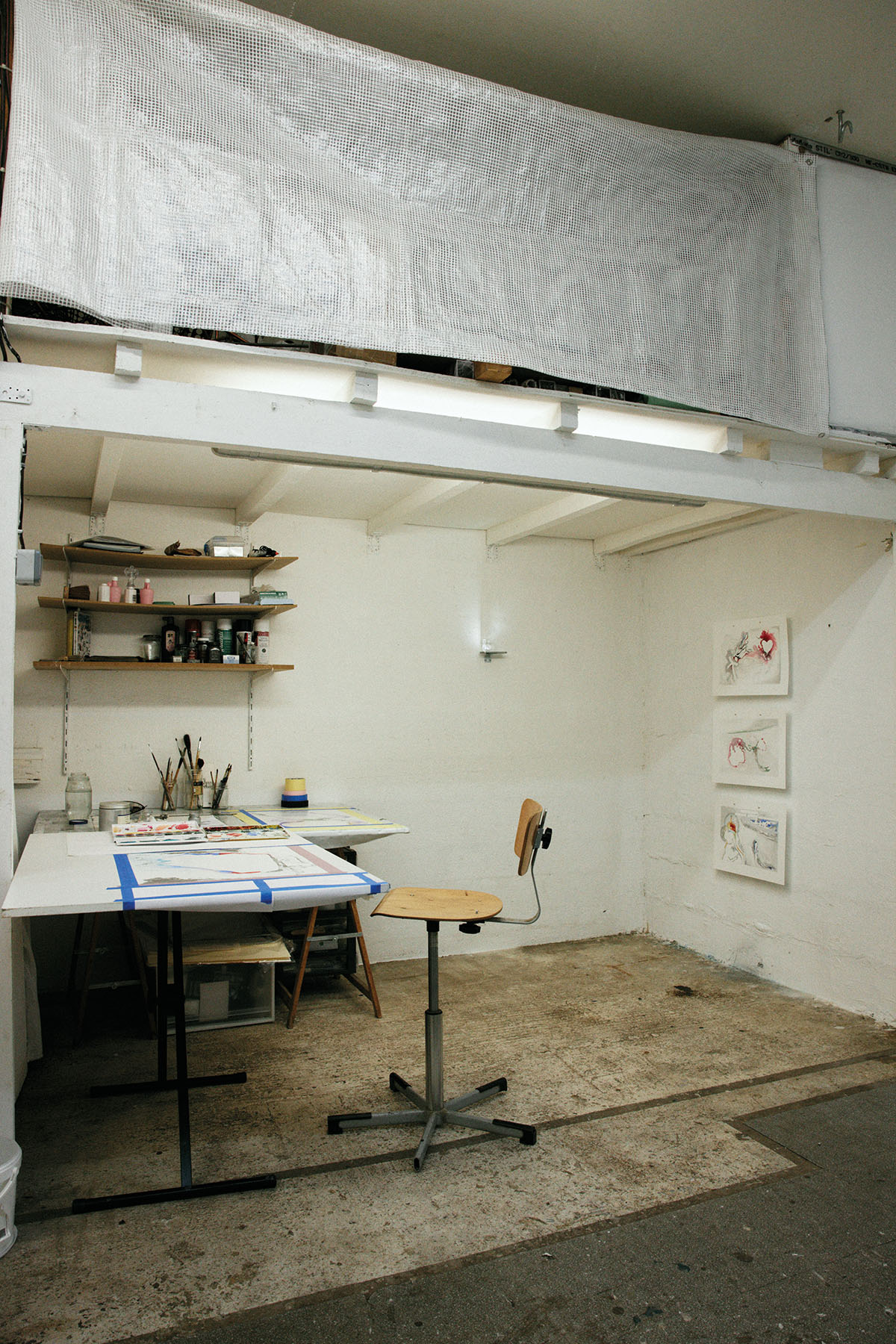
You have just returned to Paris after nearly a year spent in residency programs. How does it feel to be back in the city? From your perspective, in which direction has the city evolved in the last years?
Paris has shifted significantly. The city is more international, more fluid, and more connected to global conversations than it was a little over a decade ago when I first moved here. This is a definite plus for foreigners like myself. Artists, galleries, and cultural workers have relocated here, and the ecosystem is less insular than before. There is a sense of acceleration and cross-pollination.
At the same time, the city still carries a strong belief in its cultural legacy, which can slow the redistribution of visibility and resources. The opening is happening, but it is uneven. I find the tension productive; it forces one to position oneself consciously in relation to the existing structures. But what feels most alive today is what’s happening around the periphery of the blue chip art map: independent spaces that follow different models, residencies, and artist-run initiatives operating with less attachment to old hierarchies and more genuine exchange. This ecosystem is what makes Paris compelling right now for me as an emerging artist.
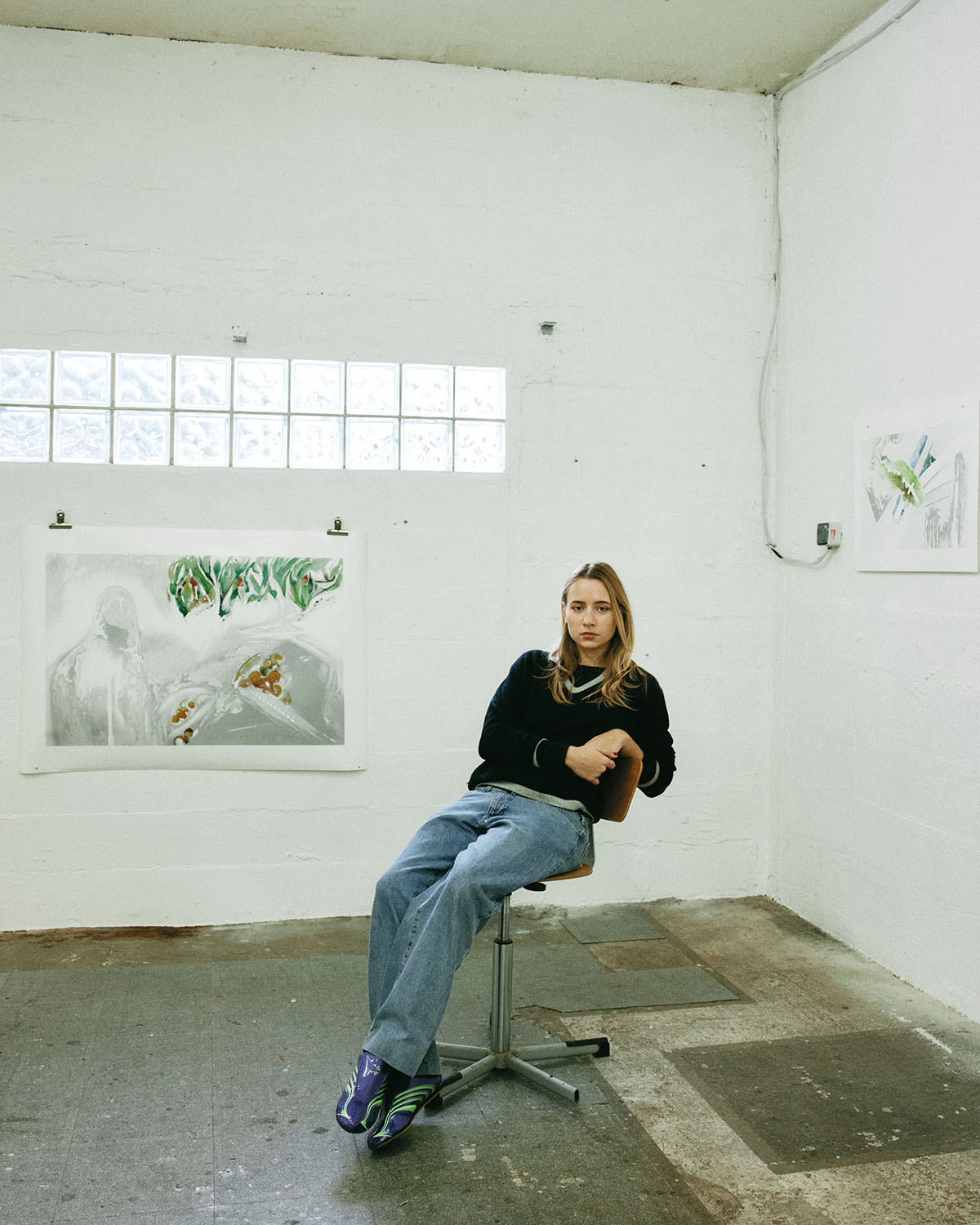
What are you currently exploring in your atelier?
I am developing two projects I began in Milan and in Naxos earlier this year. One of them, Guardian, originated as a prototype sculpture I made in residency this August. It brings together two objects that carry very different, but equally charged, symbolic weights: a small plastic angel taken from an electric Orthodox votive candle, and stacked glass insulators from high-voltage power lines. I’m interested in how each of these objects was originally designed to channel energies and their transmission — one spiritual and the other electric. Together, they slip from utility into a ritual object. The next step is to expand the sculpture into a series and enlarge it to an architectural scale. I’m sourcing a variety of vintage insulators at online auctions and exploring ways to work with glass specialists to develop the series on a human scale. The result will be an installation of a large series of these sculptures that could be walked among by the viewer, sitting somewhere between beacons, monuments, and altarpieces.

In the studio, I’m working on a drawing series, Attachments. They originate from digital images — devotional icons, holiday greetings, religious clip art — that circulate informally on WhatsApp and are sent to me almost daily by my grandmother, who lives in Moscow. I have amassed a vast collection of these greeting-card images and gifs of angels, saints, and crosses, sometimes oddly combined with roses, doves, or Soviet victory symbols, depending on the occasion or holiday. They’re a fascinating form of folk digital kitsch. To create the drawings, I work with watercolour and aluminum pigment. In the compositions, I remove the central motif, leaving a kind of absent icon: a halo with no saint, a framed silhouette bleeding color. The resulting image becomes a ghost, like a layer mask erased in Photoshop.
And as the year slowly draws to a close, what are your wishes?
My goal and direction in my practice moving forward is to develop a more sculptural vocabulary, working on a larger scale and continuing to build relationships with fabricators and craftspeople to realize my vision for more ambitious sculptures and installations. I’d like the next chapter of my practice to open up more materially and spatially. I still have a lot I would like to do: to grow my research in the direction I have taken with this latest body of work.
Ekaterina Costa – www.instagram.com/ekcosta




